#the cartoon show for children has these characters acting more emotionally mature
Text
I find it so funny how the movie made such a big deal out of Cleo and Deuce having broken up, and it’s this whole dramatic angsty thing and the first piece of info that’s given to us about these characters
And then in the cartoon show it’s just like. “yeah we dated for a bit but we’re defs better as friends, anyway-“ at like. episode 29.
#monster high#soli soliloquies#is this funny to anyone else because it’s hilarious to Me#it wasn’t even clear if they knew each other until that moment lmaooo#but also#the cartoon show for children has these characters acting more emotionally mature#than the live action movie presumably aimed at actual teens#the irony#to be clear: I’m not saying one is worse#I’m not above some petty romantic drama#but I AM saying the cartoon’s take is more refreshing in my eyes#no toxicity just vibes
32 notes
·
View notes
Note
Could the DWD reboot have a lead that composite character of the original and reboot Drakes? What are your thoughts on that?
The more I think about this the more worried about the reboot I get.
So OG Drake was what? An arrogant jerk. The Whole Point of his character was that he was so full of himself it was comedic (and his biggest stumbling block plot wise) and he was the poster boy for antisocial. He was grumpy, oblivious, and just straight up mean sometimes. We all know it's true, and it was the Point and yet we all still loved him anyway. We loved him enough that we're even having a conversation about a reboot!
Now look at DT Darkwing. They turned OG Drake into the bad guy. Think about that. Things that would have been played off for a laugh or a blunder or a *gasp* Character Flaw in the OG cartoon literally turned Drake into the villain. DT Drake was saccharine. He was tame. Any "arrogance" he had was... barely even there. He was clumsy, but he meant well. He was a Good Boy trying his best. He was watered down, socially polite, and heroic. OG Drake was none of those things and that's why we loved him. (an argument could be made that OG Drake was also heroic, and while I'd agree that he did heroic things, he himself in general never acted like a hero. He never did what was right because it was the right thing to do it. He did things for his image. And occasionally because Gosalyn and/or Honker were in trouble. But mostly for his image.)
Basically, if DT Drake is any indication of what cartoons think their "hero" needs to look like, no matter how much of the original essence they have to discard, I am not optimistic about how another reboot would handle Drake, especially not when it would have to stand alone and sell itself to kids - and helicopter parents - under it's own merit.
Speaking of Gosalyn: the more I think about DT Gosalyn the more I realize that she has nothing to do with OG Gosalyn. DT Gosalyn was determined, straight laced, emotionally distant, and mature. She was excited by danger and a little reckless, but she never caused trouble, she never disregarded the rules, she never gave anyone any trouble, and she never bullied (as a love language) Drake. Those final four character traits are exactly how I would describe OG Gosalyn. DT Gosalyn was meant to be older (despite the fact that they still used the "child" body type for her instead of the "teen" one which I have Opinions about) and there was no need for that. OG Gosalyn was a hellion of a ten year old. She was exactly in the "testing the boundaries" age, the "can't mentally grasp onto the idea of consequences yet" age. She was a constant headache for Drake, and she ADORED her father. She never wanted to hurt him, she never wanted to frustrate him, and even tho she quite often did, she still knew the line, and when she crossed it she would sincerely apologize. OG Gosalyn was in every single way a kid, and DuckTales did the writer's room equivalent of casting someone in their 20s to play a teenager. It was an unnecessary change. It only reinforces that kids today can't be kids, they have to grow up as soon as possible, so let's show them teenagers to give them a goal.
In the end, the only thing DT Gosalyn had even remotely in common with her predecessor was a similar backstory (still watered down!! Can't have death!! Kids can't handle Death!!) and a bow and arrow.
I never thought I'd be "that guy" who whines about reboots "messing things up," but I've come to realize in all these years that DT did mess Darkwing up. They either left out the soul of these characters, or worse, vilified it. Bc heaven help us, our kids can't be entertained or be expected to look at characters on TV and NOT model their lives after them! A child can't look at a jerk on TV and then Not become one themselves!! Everything should be safe!! And moral!! And socially correct!! And not scary or harmful or challenging!!
There is no more danger allowed in children's programs anymore. And how do you expect to have Darkwing without it?
It's frustrating, and it leaves me with very little optimism. Not none, but very little.
Don't even get me started on Launchpad.

Don't get me wrong, DT Darkwing still has a special place in my heart. But I don't consider it canon. It's just another AU.
14 notes
·
View notes
Text
Let’s talk about Diego Hargreeves
This is going to be a meta exploration of his characterization so if you’re not into that stuff, I’m letting you know up front.
I recently re-watched S1 & 2 of The Umbrella Academy back to back, and I saw what could be the beginning of a trend I would not like. S1 Diego is much more of a real adult than S2 Diego.
S1 Diego has a real emotional maturity and intelligence to him. Sure, he has his “cut butt, nice legs” moments and jumps Hazel, but he’s also mediating between Klaus and the vets and has other moments of emotional maturity and intelligence that mark him as a fully realized adult (and the jumping Hazel moment is completely believable and in character as he as a very solid reason for doing so, at least in his own mind). Yes, he has trauma he hasn’t worked out, and yes, he’s knife batman, but for the most part he acts the most like a normal human adult, and compared to his siblings, I would go so far as to argue that in S1 he may have the highest emotional intelligence (even if he doesn’t like to show it).
I had watched S2 more recently and repeatedly before this full-show watch, and when I went back to S1 and saw some of Diego’s behavior I was like “huh... he wouldn’t have acted that well in S2.”
S2 Diego is more of a dumbass himbo. He just is. And while it’s funny and I love it, I don’t want him to completely loose the emotionally intelligent aspect of his character in S1. S2 Diego is more of a cartoon character, and less of a strange but realistic adult man you could meet in real life. On the one hand, yeah, he did just spend 3 months in an insane asylum and that could make anyone loopy, but now that he’s out I’m hoping he’ll get some of his seriousness back.
I think there’s a happy middle ground between S1 and S2 Diego I would really like to see, almost like a toned-down Crouching Moron Hidden Badass, but more “Crouching Sometimes Stupid But Still Realistically Capable As An Adult Not-So-Hidden Badass.” I think this middle ground would be incredibly hard to hit between the delicacies of writing such a character and acting such a character, and I could understand if they leaned one way or the other.
All I really want is for the dumbass himbo aspect not to be turned up any more than it is now. Please don’t flanderize Diego, or any of the other characters I could see going that way, like Klaus or Luther. These characters aren’t idiots and they aren’t children. They have all the complexities of any adult, and the show should treat them as such.
#tua#ua#Umbrella Academy#umbrella academy season 1#umbrella academy season 2#umbrella academy season 3#diego hargreeves#luther hargreeves#klaus hargreeves#tw trauma#tw mental hospital
53 notes
·
View notes
Text
Tangled Salt Marathon - One Angry Princess
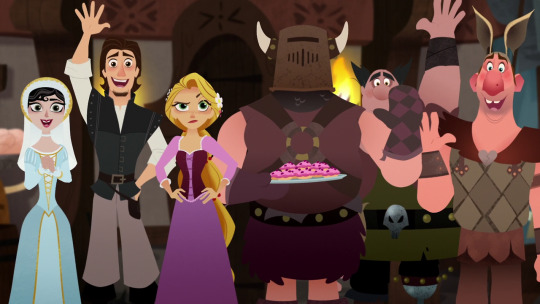
There’s two halves to this episode. The first is a well constructed, if over simple, mystery for the kiddos to solve. The other is a failed attempt at being ‘deep’ and ‘mature’.
Summary: Attila is finally opening up his own bakery, but people generally don't want to stop by because of his scary helmet. The next day, Monty's Sweet Shoppe is destroyed, and Attila is arrested. He is about to be banished from the kingdom, but Rapunzel makes an appeal to investigate the matter further.
The Episode is Meant to be a Homage to 12 Angry Men, but Misses the Point of the Original Film

So for those who haven’t seen the movie, (though really you should) 12 Angry Men is about a jury trying to decide if an accused person is guilty of a violent crime. At first the evidence seems clear, but one lone juror refuses to vote guilty until the evidence has been gone over again. One by one he convinces the other men to vote not guilty as they each have to face they’re own personal biases.
Sound familiar?
In the show Rapunzel is the sole believer in Attila’s innocence despite evidence to the contrary. She insists on investigating herself while challenging everyone else’s personal biases.
The difference?
12 Angry Men is a hard hitting look at how privilege, prejudice, and cognitive bias can interfere with the American judicial system. None of the jurors are named, but they are all middle class, presumably Christian, white guys. And that is the point. They are all different from the accused; a young, poor, arguably non-white teen (the play is intentionally vague about the kid’s race so that you can slot any minority in there) who has a history of getting into trouble. If you were to change the ethnicity, race, gender, class, or age of any of the 12 characters then you would suddenly have a very different story. It’s their backgrounds and pre-formed opinions that inform their decisions. Even the main protagonist is not exempt from re-examining his own personal biases.
Meanwhile the writers of Tangled: the Series are too busy showing off how clever Rapunzel is to actually deal with the themes of injustice and bigotry that they added in themselves in the first place.
Rapunzel Knowing Attila Before Hand Weakens the Message
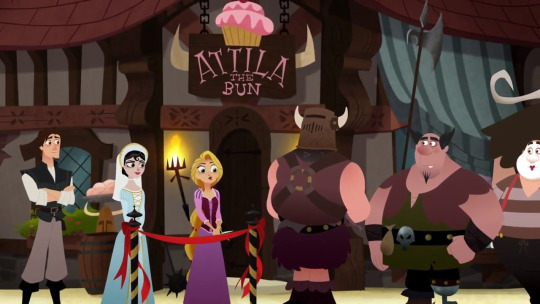
In 12 Angry Men none of the jurors know the accuse. In fact, they can’t know him. It’s against the law. In order to have an impartial jury, no one can have any ties to either the defendant or the prosecution, and they must not have knowledge of the case or have had specific experiences that might cause them to be biased or unfair.
Rapunzel being Attila’s friend means that she already has her own bias and an invested interest in making sure Attila goes free. She’s not acting out of the simple goodness of her heart here. She’s doing something that directly benefits herself.
I don’t expect a children’s fantasy show to recreate the US judicial system with all of the complexities there in, but I do expect it to uphold it’s heroine as the selfless person it claims her to be. Yet the show constantly undermines this supposed character trait by only having her help the people she befriends, and only if that help doesn’t require anything emotionally challenging or mentally taxing from her.
How much more powerful would this episode be if Rapunzel was defending a stranger or someone she actively disliked? Imagine if it was Monty who was being accuse and Raps had to swallow her pride in order to do what is right. But that would require the show having Rapunzel actually learn something instead of placing her on a pedestal. It would also mean giving Monty a reason to exist rather than keeping him around to be a convenient red herring.
Rapunzel Shouldn’t Have to Prove Attila’s Innocence
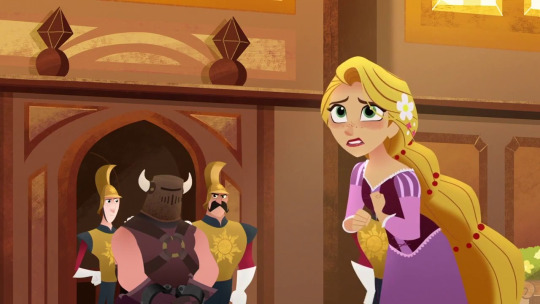
Rather than have a courtroom drama the show opts to have a ‘whodunit’ story instead. This unfortunately gives the implication that Corona’s judicial system runs on a ‘guilty until proven innocent’ mantra, which is backwards to any humane legal system. ‘Innocent until proven guilty’, ‘reasonable doubt’, ‘due process’, are the cornerstones of our modern social ethics.
In 12 Angry Men, we never find out if the accused actually committed the crime or not. That is because his actual innocence isn’t the point of the story. It’s about whether or not the system is working like it should or if it’s being compromised by human error.
Once again, I don’t expect a recreation of the US judicial system, but if you’re writing a story for a modern audience then you need to reinforce modern morals. Simply crouching Corona’s legal system as ‘of the times’ or ‘fantasy’ while ignoring why we no longer have such systems in place reduces the story to puerile fare.
It also means that show’s writers didn’t put enough thought into their world building.
No One Calls Out the Obviously Corrupt System

The show has interwoven throughout its ongoing narrative themes of classism, injustice, abuse, and authoritarianism, but then fails to follow through on those themes by not having any of the protagonists actually examine any of these issues. They just sit there in the background, even as the show tries it darndest to present Rapunzel as an arbiter of reform. However a person can’t bring about change if they can’t even admit that there is a problem to begin with.
In this episode alone we have
Banishment is considered a reasonable punishment for an act of vandalism. A crime that is usually considered only a misdemeanor unless the damage goes over a certain amount. Keep in mind that not even most felonies would be given such a punishment in the real world
Introduces the prison barge that regularly carries away convicts. In the past ‘undesirables’ would be shipped off to prison colonies as a form of persecution. Attila and every other person we see subjected to Corona’s legal system are of a lower class.
Many prejudge Attila based off his appearance, lower class, and past upbringing. However, it is either Attila who is expected to change or Rapunzel who is expected to win people over. At no point is anyone told that they shouldn’t be prejudiced to begin with.
There is no judge, jury, or lawyers. The king alone decides the fate of criminals, the Captain is expected to be the both the prosecutor and the ‘executioner’, which is a conflict of interest, and the defendant has no one to represent them unless they so happen to know a kind statesperson. Meaning you have to be either rich or well connected in order to even have a chance to defend yourself.
Oh and there’s this...

Uh, yeah you do. You’re the flipping king. You make the law. You’re the one to bring charges against Attila, and nearly every other criminal in the show, in the first place.
The show constantly wants us to view Frederic as simply an everyman who is only doing his job, but he’s not. He’s a ruler and as such he has powers and responsibilities that no one else has or ever will have. The series gives both him and Rapunzel all of the privileges of being in charge without holding them to account for the consequences of their actions.
By not pointing out how wrong these actions are, the show winds up avocating them instead. When I call Tangled the Series authoritarian, this is why. Because authority is never questioned even when clearly wrong and nepotism is presented as the solution to conflicts as oppose to being the problem itself.
The Show Introduces Complex Issues but Then Oversimplifies the Conflicts Surrounding Those Issues

The creators of the show have constantly declared that the series is ‘not for kids’. That they were shooting for an older audience than the pre-school time slot they were given. Now ignoring the fact that Tangled was always going to have a built in audince of pre-teen girls and ignoring that children’s media can be mature, TTS lacks the nuance needed to viewed as anything other than a pantomime.
As stated before, this episode alone ignores the very real issues interlaced within the conflict in order to give us an overly simple mystery that anyone over the age of five could figure out.
It’s frustrating to watch the show constantly skirt towards the edge of complexity only to see it chicken out and go for the low hanging fruit instead. As a consequence the series winds up being for no one. Too shallow for adults and older teens, but too confused in its morals to be shown to small children and younger adolescents.
I wouldn’t recommend this show to a parent, not without encouraging them to view the series either before or alongside their child in order to counteract it’s ‘lessons’ and I know parents within the fandom itself who’ve stopped showing newer episodes to their kids; stating that they want their child to be old enough to point out the harmful messages to before doing so.
Once Again No One Learns Anything

Rapunzel doesn’t learn that the system is flawed. Attila doesn’t learn to open up to people. Nobody learns to treat people with respect and to not judge others based on appearances alone.
The whole point of the episode is to just show off how much ‘better’ Rapunzel is than everyone else. The show constantly feels the need to tear down other characters in an effort to make its favs look good as opposed to just letting the mains grow as people.
Conclusion
Tangled the tv series is no 12 Angry Men. It’s no Steven Universe/Gravity Falls/Avatar:TLA/She-Ra/Gargoyles/Batman:TAS either. It barely reaches the same level as the likes of DnD, Sonic SATAM, or Voltron. Interesting ideas but poor pacing, build up, and lack of follow through, with some naff decisions thrown into the mix bring things down in quality. And unlike the Dungeons and Dragons cartoon from the early 80s, TTS lacks the benefit of being a pioneer in the field of animation, where such flaws are more forgivable.
41 notes
·
View notes
Text
Steven Universe Future reviewed: Prickly Pair
‘Prickly Pair’ explores the negative feelings Steven has been having as of late and I’m a little worried those negative feelings are going to rub off on to this review.

‘Fool!’
Before I say anything else, I will clarify that Steven cactus is the MVP of the episode. In an otherwise angsty affair, he provides the most enjoyable and comedic parts. Which is a bit messed up considering he’s being mistreated throughout the whole thing.
I will split this review into four parts; My overview of the episode as whole, my thoughts on the opening scene, a discussion of Steven’s view of the other Crystal Gems, and finally my thoughts on the episode’s conclusion.
Overview:
I think what’s difficult about watching ‘Prickly Pair’ is that it’s a pretty big downer the whole way through, with only a couple brief uplifting moments. Steven was a sad sack in the previous episode too, but that was balanced out by everyone else in the episode being pretty happy in their lives. You don’t get that levity in this Steven centric affair.

‘I gave up running the school, but now I don’t know what comes next.’
Ah that feeling of giving up your job because it isn’t right for you, but not having an idea of what you want to do next. So you start filling your time with hobbies to distract you, like gardening or writing reviews of children’s cartoons… ahem.
Almost every plot beat has Steven be depressed or anxious about something new. We start with Steven questioning what he’s doing with his life, which progresses to him venting about his problems to his newly born son, Cactus Steven. This results in Steven mistreating the cactus when it starts parroting him in front of others, exposing all Steven’s insecurities to his loved ones. Finally, this cumulates in the two fighting. And, despite ultimately making amends with the cactus, it still decides to leave him.
This does at least lead to Steven experiencing a growing moment.

‘I’m sorry I mistreated you, you’re just learning from the only role model you’ve got!’
He learns the moral that impressionable children can internalise and replicate their parents unhealthy behaviours and attitudes.
Despite learning this, I’d argue that Steven is in a worse place emotionally at the end of the episode than he was at the beginning. Steven at least had his plants to distract himself from his depression, but after the cactus fiasco I can’t imagine he’d be able to go back to that. Now he has no hobby to consume himself with, and has to deal with his family knowing about all the negative feelings he was trying to keep hidden from them.
This is probably something that will benefit him in the long term; the gems are aware how much he needs their support now. But in the meantime he’s left feeling pretty low.
And that’s sort of how I feel about this episode. By itself I don’t really enjoy it that much because of how negative it is, even though in the long term I can acknowledge this was probably a necessary step in Steven’s journey.
That acts as my general overview of the episode, but now to get into more specifics.
Potty for Potted Plants:

‘This little smarty is named Connie.’
Awkwardly drawing attention to the fact that we haven’t seen Connie since the movie… a movie she was barely in.
The episode opens with an introduction to the plant colony Steven has been growing, each of the plants being named after one of his friends. Steven naming his plants after his friends is something that could be seen as cute, but it’s portrayed as an unhealthy coping mechanism from the get go; as Steven rambles about how the plants can’t leave him. A dark reading of this behaviour suggests that he wants his friends in a position where they physically can’t leave him, and also depend on Steven to care for them for their own survival.
While I can appreciate the subtext I still didn’t care for this scene in general. Particularly the part when Steven starts talking to the Lars plant.

‘You’re stuck in the ground aren’t you not going to zip into space and leave everyone behind’
I personally find it annoying when a character just starts rambling like a crazy person for comedic purposes. Particularly if the content of what they are saying isn’t that funny: Steven’s pretty much just summarising his insecurities for the audience right here.
Steven’s plant obsession is supposed to be comedic in its creepiness, but I just don’t find this creepy behaviour comedic.
It does serve its plot purpose, although having Steven literally name the plants after his friends feels so on the nose. Just have him ramble about how plants can’t leave and we’ll get it.

I’ll give them the onion joke though
I’m assuming Garnet’s ‘You should keep a close eye on your cactus.’ line is her using her future vision but…. What exactly is she seeing? Her later line of dialogue ‘that cactus really bounced back’ suggests that she was just warning him about over watering it, but that seems like such an inconsequential thing for Garnet to care about. Did she see the events that played out in the episode, where the cactus comes to life and started attacking them? I feel like if that’s so then she surely would have known about Steven’s mental state from the beginning. Also her warning Steven about the cactus is ironic as it is inadvertently what caused those events to happen in the first place.
I don’t know, I think she knew something was up with the cactus but I’m not sure what.
It does at least act as an example of her ‘high and mighty advice’ Steven complains about later in the episode. Speaking of...
Steven VS The Crystal Gems:
This episode contains Steven’s most sinister character moment yet; slagging off the crystal gems behind their backs. Let’s break down each of Steven’s ‘critiques’ of the crystal gems to assess their validity.
‘I can’t let Pearl know how I feel because she’ll blame herself and spiral out of control, and I’ll have to pick up the pieces!’
This is by far the harshest of Steven’s outbursts, and a pretty low blow considering all the trauma Pearl went through. But on the other hand Steven had to resolve a lot of Pearl’s issues for her from a young age, so I can’t really blame him for feeling this way. In fact if this complaint had been made before the Pink Diamond reveal I would have been fully in Steven’s corner.
It is ironic because you could say that Pearl unloading her trauma onto Steven traumatised him. And now in turn Steven is unloading all his issues on to Cactus Steven. Definitely a message in here about parental figures passing on their baggage to their children.
‘I don’t want any more high and mighty advice from Garnet.’
I found this one funny because it just reminded me of his impression of Garnet in season 1’s ‘Tiger Millionaire’
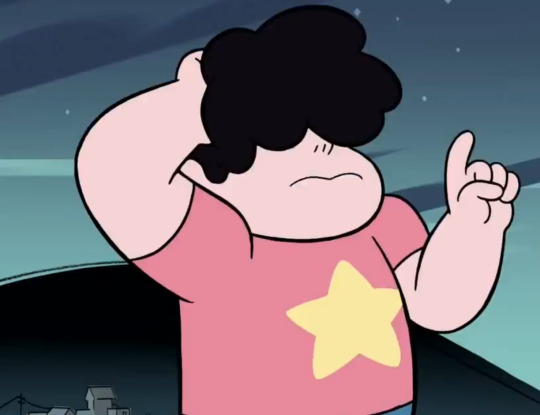
‘I’m not going to say anything, but I expect you to understand that was wrong.’
Ah, the more things change the more they stay the same.
‘And I’m so sick of Amethyst acting like she’s so mature now’
This is the rant that comes most out of left field, especially as Steven was the one who first labeled Amethyst as ‘mature’ back in ‘What’s your problem.’
His issues with Pearl and Garnet make more logical sense as those are reactions to problems he feels he needs to deal with himself. But Amethyst's maturity isn’t something that negatively impacts Steven.
In fact, in the very next scene Amethyst's maturity is the thing that encourages her to reach out and ask if Steven needs any help. Steven’s distaste for Amethyst maturity comes across as plain pettiness towards her growing as a person. The two have somewhat switched roles from the episode ‘Steven vs. Amethyst’.
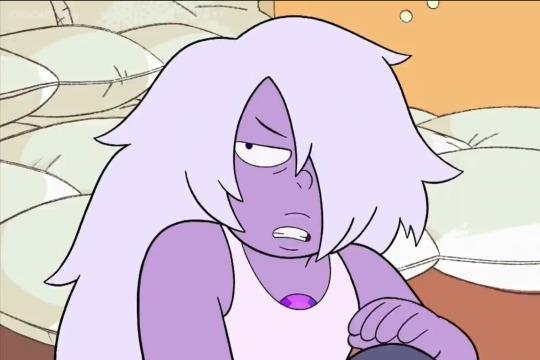
‘Great and now you’re even more mature than me [...] Now I’m the worst Crystal Gem’
Here, Amethyst was bitter that Steven was starting to excel past her. Steven improving as a person made her feel worse about herself. Both of them have felt bitterness towards the other showing maturity and character growth . But of course, being resentful of someone else’s maturity only makes you seem more immature.
The Final Fight
It takes Steven having a physical fight with the cactus to realise the only reason it is being so aggressive is because it’s copying him. Which is weird because Steven knew the cactus was learning by copying him from the beginning.

Like, come on man you already knew that, it should have been pretty self evident.
But obviously Steven was so preoccupied by his annoyance the cactus that he completely forgot this.

The reactions to the cactus pricks make for some great visual gags. But I feel they overplay this joke, it’s done like 5 times in the final scene alone.
Because the cactus only copies Steven, all of Stevens' anger directed the cactus is really just anger at himself. This metaphor is made even clearer by the cactus literally being a cactus version of Steven. So Steven’s realisation that he shouldn’t have been so hard on the cactus doubles as a realisation that Steven shouldn’t have been so hard on himself, (although I don’t think Steven made that connection) So there’s a double moral here that one should be kind to them self as well as others.
15 notes
·
View notes
Text
hey its me again wall of text sorry not sorry
k i saw your little treatise justifying zadr and yknow its a cartoon its not the worst thing ever of course nobody is gonna sue you for reblogging fanart or burn you at the stake or w/e and im glad you decided to open yourself up to a differing opinion but zim IS portrayed as an adult. there was even an unfinished episode where zim’s childhood and growing up training from start to finish would be shown so by the time of the pilot he is definitely a full grown developed adult by irken standards especially if hes a former member of an elite military force like the invaders. jhonen has said that the irony and sad comedy of zims character is that hes a grown ass man and a war veteran to boot who VOLUNTARILY goes to an elementary school every day and throws hands with an 11 year old boy who should be well below his notice because he’s that pathetic and desperate for validation that he’ll stoop to seeking it from a child. it also sets up a dynamic between them where dib is CHALLENGED by having to go up against an adult with way more experience than him while dib is just a child, so when he wins its more meaningful, which is a common trope in childrens fiction that an underdog young hero has to take down a powerful adult villain.
jhonen might joke a lot but he’s serious about this part of the characterization of zim and dib and he even went to great lengths to make dib look and act more like a kid in ETF (more emotional and naive, designed to look smaller/softer, going in depth with his relationship to his dad and sister and needing his dad to protect him at the end when he’s too overrun to fight alone) just to drive home the point of how young he is. it was a very deliberate move and jhonen knows what hes doing ESPECIALLY since he also left zim pretty much unchanged and also includes gags about zim’s relative maturity like animating him briefly grimacing because his joints are sore and the part where he pretty much gestures to his crotch and goes “theyre afraid to look at ALL-A THIS”. like you would not see jhonen do that sort of joke with an underage character ok. dont confuse his social awkwardness and self deprecating/trolling humor for not knowing the difference between right and wrong and not acknowledge when he means something sincerely because he doesn’t just clown on people and troll ALL THE TIME 24/7 hes a human, and times have changed with more awareness on issues such as the grooming of minors so he can go back on things he may have said in the past that he doesn’t agree with now or said by mistake. he has said enough times that zim is older than any human alive that its safe to take his word for it by now. judging by the one strip he did in JTHM about johnny murdering a pedophile who was about to prey on squee i think his stance on protecting kids is pretty clear. also i wouldnt put it past jhonen to have redesigned membrane to be more chaddy looking to divert the adult fandom’s attention away from dib and throw the fangirls a bone but thats a whole nother can of worms lol.
and the justification that zim is immature so hes essentially on dib’s level is a reversal of something lots of kids hear from either creepy or ignorant adults who tell them theyre “so mature for their age”. no matter how emotionally mature you are it wont ever compensate for the number of years youve been alive so that’s not very sound logic, and even in fic where theyre both adults it’s still pretty weird because it doesn’t erase their history where zim knew dib as a kid. that’s sort of like a grownup waiting with bated breath until a kid is “legal” so they can start dating. kinda like when jacob imprints on bella’s newborn daughter in twilight then having it handwaved away by saying he’ll wait till she’s grown up, which understandably drew a huge amount of criticism. it’s a loophole that might be mildly acceptable in some cases but the context leaves it colored with a residual ickiness that sets off some red flags for me and a lot of other people.
also you said zim is an alien and therefore the situation itself is unrealistic, but the reason invader zim’s writing resonates with people is because zim is written with very HUMAN emotions and motivations and part of the humor again is how irkens despite being aliens from another planet mirror some of humanity’s worst flaws such as being petty, gluttonous, willfully ignorant, arrogantly believing they are special and better than everyone else, easily manipulated by propaganda, all too eager to greedily colonize other societies etc making them not so different from us at all. so the premise out of context might not seem realistic but the idea of a sad burnout adult who doesn’t realize how humiliating it is to be consistently outsmarted by a kid less than half their age IS realistic and applicable to human interaction since we’ve likely all met someone like this before at one point in our lives for example a schoolteacher who has a personal vendetta against one or more of their students and has nothing better to do than antagonize them, or a really dumb parent that you fight with a lot.
another thing, i know you and other fans probably have a lot of sentimental value and nostalgia attached to zadr because you probably shipped it back when you were a kid yourself and you cant be blamed for something you liked as a kid, but youre an adult now, and you have to listen to the portion of kids in the fandom who dont like zadr and say without question that the age gap makes them uncomfortable. those kids ARE the priority. we’re grown up now and we have to put our feelings aside for them because that’s part of being responsible and mature. i feel like zim himself is a pretty good example of how not to act at our age [shrug emoji]
and anyway a lot of the same elements of zadr can be explored with zadf just as well with just as much potential for cute moments and as a bonus is it’s not creepy
You do bring up some good points, and I’m not saying you’re wrong... But honestly I’m still not convinced. I mean, stuff that Jhonen said, the thing is even if it’s the author saying it it’s still outside of canon, that’s the reason why Neil Gaiman got flack for Good Omens because they didn’t write an actual kiss or hug or hand-hold between Aziraphale and Crowley yet Neil Gaiman went on Twitter saying they were queer representation. I still don’t really put much stock into what he says because the unfinished episodes and Jhonen’s commentary don’t really change the dynamic that’s actually in the show. And again...Jhonen said if there were going to be romance in the show it would be Zim/Gaz, so he’s either a huge hypocrite or doesn’t view Zim as being incompatible with Gaz.
I do think it’s much better when Dib is an adult and it just makes more sense, and I actually do prefer zadf to zadr and if i were going to ever write fanfiction or make fanart it would probably just be zadf, just because i know this does have some stuff to think about and I totally respect that you have a different view of it, but i honestly just don’t see it that way. The analogy with Jacob imprinting on Bella’s child in Twilight isn’t really the same thing honestly. The author in that situation tried to make it not......that....by saying that imprinting isn’t always a romantic relationship thing, and that Jacob would be more of an older brother, but honestly that doesn’t really negate the impact of grooming that kid would have with Jacob around. The idea that Zim would somehow be grooming Dib seems really silly to me although you’re right, I think his characterization in Into the Florpus has evolved somewhat especially with regard to Dib wanting to get his father’s approval, but again Zim has parallels with that in trying to please the Tallest. the world-building and characterizations are inconsistent and scattershot at best. Like no, zim isn’t waiting for him to turn legal, that’s absurd, they’re nemeses coming at each other then learning to be friends. You’re right that that doesn’t have to be zadr but I still tag it as zadr so people can block it if they want to.
Like, I’ve seen people ship Zim with Professor Membrane instead of Dib. That seems very weird to me. that professor membrane would have a relationship with someone who literally goes to his son’s elementary school and who doesn’t know anything at all about human behavior and emotions.
I feel like with this discussion people don’t really understand the problem with age gaps. With age gaps, it’s not a matter of mature/immature, it’s about development. A ten year age gap sounds like a lot right? a 25-year-old and a 15-year old would absolutely have a predatory “relationship.” But a 35- and a 45-year old, that’s perfectly fine. Having a difference in age doesn’t automatically make the relationship unhealthy. so if Dib is 25 and Zim is [whatever the hell aliens years i still don’t really take Jhonen’s word for it bc he’s not consistent], that’s doesn’t mean it has to be bad. The thing about telling minors they’re “so mature for their age” to try and convince them that a person interested in them isn’t a pedophile is that we know a human being who is 15 isn’t developmentally at the same level as a 25-year-old regardless of their behavior. What is Zim? All we have to go on is how he acts, and he acts like Dib is an equal match, it’s not “he’s immature for his age,” it’s very unclear. Raw number of years isn’t the ultimate decider, for example in DnD lore elves reach maturity at, like, 100 years old so a 25-yo human trying to get with a 50-year-old elf would be predatory to the young elf even though the “younger” one is technically twice as old as the human. Do you see what I’m saying?
I also don’t really buy the idea that Invader Zim’s writing resonates with people because Zim is ~~so human~~. The guy steals a bunch of kid’s organs in one episode and flies into a tantrum over the slightest inconvenience. You have to be reading really deeply into it and dig into some old internet archives of things Jhonen Vasquez has said to paint it as realistic. You can do some interesting things with it wrt like, Zim being defective and starting to experience human emotions but that’s mostly fanon.
Well, you’ve given me some things to think about, thanks for explaining your side to me. I’m still going to tag things as #zadr so people can block if it can’t plausibly be categorized as zadf. I’m not actually making any fan content for Invader Zim so the point is kind of moot, but if I ever do I’ll definitely take this into consideration.
36 notes
·
View notes
Text
South Park: Bigger Longer & Uncut (1999); The “TV Show: The Movie” that Pushed its Source Material into the Future
There was a time where “TV Show: The Movie” movies had broken into the mainstream, and not always for the better. Starting around 1998 with the release of “Rugrats: The Movie”, which went on to become the first Non-Disney animated movie to gross over $1,000,000, company executives and Hollywood producers alike took note and suddenly a big-budgeted wild fire tore through the vast forest that was television; “Recess: School’s Out”, “Hey Arnold! The Movie”, a trilogy of Pokémon movies, “The PowerPuff Girls Movie”, “The Wild Thornberry Movie”, “The SpongeBob SquarePants Movie, even the most obscure cartoons of the time like Disney ‘s “Teacher’s Pet” took a try at becoming the next box-office phenomenon. From 1998 – 2004 alone, 15 movies were produced based on television cartoons, almost all of which were just clear cash-grabs to capitalise not only on the brand’s popularity, but the success of "Rugrats: The Movie", and most often, the quality reflected the profit. Whilst a majority of them did make back their budget and then some, barely any were competing with the numbers shown by the Rugrats a few years prior.
I feel that was because audiences quickly grew accepting of what the quality of the majority of these films would be; just nothing more than a feature length episode of the show that didn’t take any advantage of what the film medium could offer. Regardless however, at this time, “South Park” creators Trey Parker and Matt Stone, not being one to not just aboard an opportunity to cause a ruckus in the media, took it upon themselves to bring their ever-so controversial cartoon about the residents of a small Colorado town with a vast catalogue of bad language to the big screen.
In 1999, the two released into cinema what I still believe to be one of the boldest and most important steps the South Park series had to take in order to be where it lies today; By taking everything that worked about the show, and using every advantage the film medium could give to make one of the most simultaneously funny, vulgar, offensive and yet smart animated films ever made.
After their favourite Canadian TV starts Terrance and Philip release their feature film debut “Asses of Fire”, young South Park residents Stan, Kyle, Cartman and Kenny (all voiced by Stone and Parker) become fixated with the movie’s offensive language, with the starts often referring to each other as “Pig Fucker” or “Uncle Fucker” When this language interferes with the boys’ lives, primarily when Cartmans tells his teacher to “suck my balls” or when Kenny kills himself trying to set his fart on fire like Terrance and Philip do in the movie, the parents of the town start a protest group which starts as an attempt to get the film banned in the United States, that very quickly spirals out of control and leaves Kyle’s mom arresting the controversial duo and becoming President Clinton’s Secretary of Offence as the country declares war on Canada. With only two days before Terrence and Philip are executed, the children of South Park quickly scramble to find of a way to show their parents that they’ve got too far, whilst their deceased friend Kenny also tries to warn them of how the day of Terrance and Philip’s death was prophesised by Satan himself to be the day he returns to bring 1000 years of darkness unto the Earth.
As you may have been able to gather from that plot summary alone, there are a lot of views and themes going on throughout this movie’s short 76 minute runtime (a length I personally believe plays well into the “Bigger, Longer & Uncut” subtitle of the movie. Aside from the obvious circumcision joke) Perhaps the film’s biggest statement is not-only ironic but contradictory method the children’s parents have in tacking “Asses of Fire” and its obscene content. Rather than taking more interest in what their children can and can’t watch for example, they instead feel the need to put the blame not only on the creators of the movie, but their country of origin instead (perhaps also a metaphor for the blame people put on a country rather than just those responsible. This film did release a year after the 1998 United States Embassy Bombings and does feature a deceased Saddam Hussein as Satan’s emotionally abusive lover after all). These parents getting radical over obscene language could also clearly stem from the controversy “South Park” itself was facing at the time with parental groups during its original 3 season airing, back when the show’s animation was the cardboard cut-out equivalent to an early 2000s flash animation on Newgrounds.com. This point is very interesting to me as not only does it act as Matt Stone and Trey Parker’s “meditation” so-to-speak about all the attention they had created for their show, but it also marks them doing it in a much more mature way
At least, as mature as a show like South Park can be.
Rather than have the victims of their cynicism be wild, screaming idiots like the earlier seasons of the shows often portrayed them as (still to a funny extent, mind you.), the movie often portray the antagonists, such as Kyle’s mom, as being so self-sure that they are completely blind to the true consequences of their actions. A perfect example of which is seen in the musical number “Blame Canada”, which has a chorus consisting of the protesting, parents chanting:
“Blame Canada
Blame Canada
We need to form a full assault
Its Canada’s fault!”
That’s another thing I failed to mention. This film is a straight up comedy-musical. Decades before they showed many their talent at catchy musical writing with their Broadway show “The Book of Mormon”, Matt Stone and Trey Parker wrote a grand total of ten original songs, preforming almost all of them as well, for a South Park movie of all things. Regardless, almost every song on the soundtrack is hilarious and ridiculously catchy, with some of my personal favourites being the before mentioned “Blame Canada”, as well as Terrance and Philip’s lead single in the movie “Uncle Fucka”, Principal Teacher Mr. Mackey’s lesson on alternatives to swearing “It’s Easy, M’kay” and Satan’s solo number “Up There”, which hilariously is the only original song on the soundtrack to have no swearing despite it being performed by the prince of darkness himself.
Despite the before mentioned accolades, there are a few gripes I have with the movie that keep it from being the almost perfect movie I feel it so desperately wanted to be. For one thing, the entire “Satan will rule the Earth upon T&P’s death” subplot only really added up to Satan standing up to Saddam and his emotional abuse he gave (again, something pretty funny for the prince of darkness to endure), and that school teacher Mr. Garrison’s hand puppet, Mr. Hat, replaces Saddam.
In fact, almost the entirety of the ending does feel very rushed.
On the night of Terrance and Philip’s broadcasted electrocution, complete with a pre-show performance by South Park resident Big Gay Al, the kids with the assistance of a small French child known as “Ze Mole”, whose accent and extreme hatred for God make him one of South Park’s best one-off characters, attempt to save the Canadian comedians, only for an ambush by the Canadian Army and a resulting firefight to result in their death, unleashing Satan, Saddam and all of Hell onto the Earth. In almost no time at all, Satan realises how Saddam has used him and casts him back to the fires of Hell, calling off his attack in the process (Oh, and Kenny’s face is finally revealed. Surprise! He looks just like all the other characters in the show except with blond hair) Sheila and the parents realise how they went too far and all is forgiven as the town reprises the opening song. All of which take place in the span of 5 – 10 minutes. Whether this was due to Stone and Parker not having any more funny material, wanting the film to conclude with the same cheeriness of the opening (hence the reprise) or just simply not knowing how else to end it aside from, well, ending it.
Regardless of an ending that could have done much more than what it did I fell, the rest of this movie is almost flawless. Some may complain about the crude, cardboard cut-out artstyle and the resulting stiffness of movement, but honestly, I think it just adds so much more the film’s crudeness. Aside from that, almost every single joke, from the recurring gags from the show to what is newly presented, had me having at very least a snort and at most uncontrollable laughter. All of which is captured by the amazingly funny music and solid performances, even from the most unlikely of celebrity cameos, such as George Clooney as the doctor trying to save Kenny’s life. This film, like the show, is definitely an acquired taste. If you’re willing to possibly have your beliefs mocked however, you just may find something in this almost perfect TV-to-movie adaptation.
2 notes
·
View notes
Text
She-Ra and the Princesses of Power: Season One – Review
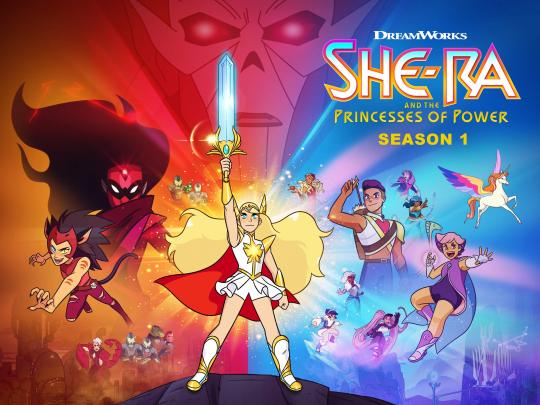
Developed by Noelle Stevenson
2018, Netflix
13 episodes, 24 minutes
Rating: ★★★★★
Good: Diversity, character writing & relationships
Bad: Lackluster ending, unoriginal worldbuilding
I grew up right outside the window where toyline-centric television shows were at their peak in popularity. Being a 90’s baby and living in a French Canadian community made it so I didn’t get exposed to He-Man and the Masters of the Universe, Thundercats, G.I. Joe, and other 80’s cartoons. The only shows I was ever really able to get into were shows like Teenage Mutant Ninja Turtles, or whatever aired before 6 am on YTV, like Voltron or Megaman. My first real exposure to 80’s cartoons was through Robot Chicken, which parodied these kinds of shows a lot. All this to say I had little interest in this era of animation. I hesitated to watch She-Ra and the Princesses of Power for this reason. I was afraid that She-Ra would require some investment in the She-Ra/He-Man mythos, or the show would be targeted exclusively at young girls. It was the blogs I follow on Tumblr that eventually convinced me to watch the show on Netflix. The response the show generated was positive, praising its diversity and interesting characters. And while She-Ra is definitely targeted towards young girls (of which I am not), I very much enjoyed it. Noelle Stevenson manages to present a compelling story, with complex and diverse characters who never feel patronizing or shallow—as characters in children’s shows tend to be. The world-building is also well-done, and requires no prior knowledge of the She-Ra/He-Man mythos from the 80’s. My only issues with She-Ra and the Princesses of Power is its resemblance to other shows and a lackluster ending, but these are small prices to pay for it brilliant execution.
I realized around midway through the series how closely She-Ra resembles Avatar: The Last Airbender, with some passing resemblance to other cartoons like Steven Universe or Adventure Time. Everything from the humour to the major plot points felt familiar and already done. Though, I have a hard time really criticizing She-Ra for its lack of originality as it can be difficult to create something new that’s appealing to everyone. Except, the show doesn’t really have its own identity. It has some great execution and a unique approach to character relationships, but I feel like the writers could have spent more time fleshing out the world and making it stand apart from its contemporaries.
This lack of originality also contributes to my only other criticism with the series: its dull ending. There’s a lot of build up to the final showdown between the kingdoms of Etheria and the evil Horde. I was genuinely invested in the outcome and anticipated that we wouldn’t get a happy ending, based on the way things were progressing. I was then disappointed in how the conflict was ultimately resolved. It felt sloppy and rushed when compared to character development. I wasn’t upset in the way things ended; I enjoyed seeing all of the princesses participating and winning the day through friendship—I had no issue with that. It’s just that it felt more akin to the ending of a Saturday morning cartoon one-shot episode than an epic thirteen episode arc. It’s a shame because there’s so much work put into the characters; that the same couldn’t be true for the main story plot is disappointing. I don’t know if this was due to bad writing, bad planning or intentional constraints by the creators to focus characters, but I hope we see better plot writing in the next season.
One thing that becomes clear as the series progresses is how devoted the writers are to having a diverse cast of characters. Nearly the entire cast is made up of girls or women, with the only male characters being Hordak, Sea Hawk and Bow—with Bow being distinctly feminine in appearance and mannerism. Characters are also diverse in body type and skin colour: Bow has dark skin, Glimmer is a bit chubby and Adora/She-Ra is noticeably tall and fit. I am always onboard for more diversity, especially in children cartoons, where it is important that children can see themselves represented in media. What’s more, none of the characters actively point out these differences beyond some comments on how tall or strong She-Ra is. There’s a clear sense of normalcy to this diversity. Of course, it’s important to directly address issues of sexism, racism and other types of discrimination directly, but it’s nice to have a show that presents these differences as normal. I also tend to find shows with diverse characters much more interesting and memorable than ones that have three or four of the same milktoast characters with different names, but no real difference between them.
She-Ra also doesn’t shy away from homosexual relationships, having one explicit relationship between the princesses Spinnerella and Netossa, and an implied relationship between Catra and Adora, with Scorpia also being enamoured with Catra. It could be argued that Glimmer and Bow are also part of the show’s LGBTQ representation, but I don’t think the writers intended it as such. Just because Bow has some feminine qualities and doesn’t have a romantic interest doesn’t mean he is gay, nor is there any indication that Glimmer, Adora and Bow aren’t more than good friends. It would be nice to have some homosexual male representation, but as She-Ra is a show targeted at young girls, I can see why it wouldn’t be a priority. Catra and Adora’s implied relationship was one of my favourite parts of the show. In what is essentially an angsty teen romance, the two go back and forth as Adora struggles to reconcile her past while Catra feels betrayed and abandoned. The execution of their interpersonal conflicts is really well done, and is the highlight of the series so far.
Most of the relationships are of this same quality. It very rarely feels like characters are acting just to push the plot forward, and interact with each other in a very human way. Drama is handled well, and nothing is ever pushed to the extreme. One of my biggest gripes with teen dramas is how relationships in those stories are handled, with everyone overreacting and refusing to discuss things openly with each other. By contrast, characters in She-Ra are mostly honest, sincere and actually talk to resolve conflicts. And when they’re not being emotionally mature like this, we immediately feel the impact of their actions. People get hurt or feel their trust is betrayed, but it’s always realistic. Glimmer is a brat, but considering how strict her mom is, her anxieties feel reasonable. Catra’s temper is a logical consequence of her upbringing, so her lashing out against Adora makes sense, especially when we see the internal conflicts she is dealing with. She-Ra trusts its audience to take enjoyment out of a well-crafted story, rather than creating drama for the sake of drama. I find that overdramatic social situations in fiction lead to people to exaggerate their own lives in turn, embodying the mantra: “Art imitates life, life imitates art”. People want to emulate their interests, even as we become more and more obsessed with crafting an exciting life for ourselves, regardless of the negative impact it has on us and the ones around us. Shows like She-Ra demonstrate that you can have an interesting, exciting life while maintaining healthy relationships with others. Relationships in fiction should help us understand the way we approach our own relationships through realistic representation; fiction shouldn’t be glorifying drama and romanticizing broken relationships.
She-Ra is the kind of show we need more and more in the modern age. It has its issues—like most things do—but just as with Adventure Time and Avatar: The Legend of Korra, She-Ra and the Princesses of Power demonstrates that we have a deep appetite for diversity and sincere character development. One thing that people often forget is that popular media has only really been around for a century, but discrimination stretches much further back. Shows like She-Ra help to chip away at the status quo, bit by bit revealing a much more interesting, diverse and accepting world, where everyone has a place regardless of who they are. As more and more of these kinds of media are featured to large audiences, diversity will become commonplace, allowing for more interesting media to be created in turn. And if even half of them are of the same quality as She-Ra and the Princesses of Power, we’re in for a wild ride.
Official Show Website
#my reviews#review#television review#shera#she-ra#she-ra and the princesses of power#spop#she-ra and the princesses of power season one review#noelle stevenson#netflix#dreamworks#fantasy#world-building#worldbuilding#world building
1 note
·
View note
Text
me rambling about a show after too much tumblr salt
being so utterly bored lately, I caved and started watching the reboot of "voltron". the rabid fandom and some of, what I see as pandering changes, had put me off. I'm around 4/6 episodes into the first season. first impressions are: - the animation is pretty good, I visually appreciate, and not overly that unfortunate mix of anime+western stylizing. after "totally spies" I couldn't take it anymore. sorry. - all the pilot characters act roughly the same age despite the mass amount of debate and drama over it. it's insulting people forget that, but especially in animation, people have different body types (which makes it more true to life, in that much at least). - some of the voice work is weak, along with the script. maybe that's just me being used to high budget animated western films and subbed anime. but it's very detaching leaving me not caring about anyone. - I've forgotten how much you can and can't get away with in western "children's" shows. can't say "die/kill" more than once or twice but have a male aggressively hit on a girl that isn't interested is fine, also torture is fine. "I'll destroy you!" boy that takes me back. really makes me realize how American tv animation shaped me in childhood actually. lol - I know it's a "kids show" but, from my impression of the fandom, I expected it to be a little more... hmm.. "emotionally" deeper than its been. that's just me going in with higher expectations due to viewing some really heavy (and great) anime in the last year, so I gotta really lower the expectations. - for all the wangst over the shiro character, I was expecting someone who acted like he was a bamf with the maturity of a 40 year old veteran. he's literally a kid himself. he's literally as much a "teenager" as the others, only with more leadership experience and a year worth of ptsd. - I get why lance is so popular at the same level I get why his "type" of character is popular in whatever fiction it appears, but other than that I don't get the hype. not unless he has some really emotional journey/growth in the future (I would be there for that but again, expectations lowered) - one thing I note and appreciate despite many flaws, is the use of ptsd--not ignoring that aspect after a character faced prisoner life. kudos. but, besides that, it's missing emotion, imo. - pidge getting actual character background I appreciate. I'm given reason to care about her and shiro but not the other 3. not yet. that all said, it's a kids show, with a horrifying fandom, so I'm not sure what I expected. but I'm going into it from the pov of someone who watched the original way back when it was on cartoon network for a while, and having watched a few episodes of the original Japanese version a couple years back. so this isn't *fresh* and new. just updated changes for me. I expected more from the hype. but maybe I'm not far enough in yet or too dead inside these days.
#rambling#voltron#I loved the princess in the original cause of all the pink tbh#delete later probably#delete#okay but in the original Japanese version pidge has the same va as goku I'm..#she's everywhere#in a good way#also in galaxy express 999#queen
4 notes
·
View notes
Text
Character Research, Tuesday 12th November: Essay Final Draft
To what extent can Jo Lupo be described as a strong female character and how does her animated alter-ego contradict this?
Imagine a town in the Pacific Northwest of America (Oregon,) that’s full of the world's geniuses. Life there shifts from incredible innovation to total chaos. This is A Town Called Eureka. The TV show where my character that I am going to be talking about comes from.
Jo, played by Erica Cerra, is my favourite character from the series but that’s not why I chose to analyse her. She’s interesting. In terms of characterisation and development she goes on a journey. We get to see her grow and become vulnerable in a very mature way.
In this essay I’m going to be discussing the factors that make Jo a strong female character but I’m also going to analyse the internal battle that she has with herself and how the her animated alter-ego could possibly be a representation of a repressed desire. The classic female character is sarcastic, never nervous or uncertain. Angry but never vulnerable ad they don’t need a romantic partner but they have one any way. All of these are tropes that Jo possesses.
Jo Lupo starts off as a guarded individual our introduction to her is as a closed off deputy who can disassemble and reassemble a gun in a matter of seconds.

Fig. 1. Jo in season 1 episode 1, first meeting
Throughout the series we learn that Jo is very much an ally archetype character (Vogler, 2007.) She sticks by and acts as a support for our hero Jack Carter. Emotionally and physically. Mostly physically. This makes Jo the ally character because according to Vogler the Ally archetype acts as moral support for the hero and follows them on the hero’s journey.
She always has a weapon with her, and goes armed even in situations where weaponry is unnecessary.Jo has a love of weapons, with a varied and powerful collection stored in the station. She is also unusually strong for her size as she can manhandle Jack Carter with ease. The residents of the town and their odd experiments try her patience, but those few moments where she gets to shoot something are the moments that Jo enjoys and looks forward to the most. The residents themselves know and trust Jo, She’s very dependable and gets the job done.
Jo is also extremely independent to a fault. Based on this information it would be reasonable to assume that Jo’s animated alter-ego would be a character similar to Mulan. (Disney’s Mulan 1998) But that is not the case.

Fig. 2. Mulan facing off the Hun Leader (Acuna and Oswald, 2019)
Mulan is stubborn, determined and, as she shows when she climbs the pole, surprisingly strong. It isn’t just strength that determines a strong female character or any strong character. They need to be strong of the mind, able to face adversity head on and move on from it, they need to be stubborn/independent to a fault because that’s how they grow and change.
In the episode Noche de Suenos Jo reveals to Carter that she wanted to be a dancer as a young girl. In the same episode it is also revealed that she grew up without a mother but was old enough to remember the costumes her mother would make for her for various roles in school plays. Without her mother Jo grew up with three older brothers and a father. This led jo to believe that she had to “learn to survive” and so she gave up on her ambition to be a dancer.
This portrays a softer side to Jo’s character. A vulnerable side even. In the shows last season it’s also revealed that Jo is a big fan of weddings to the point where she likes to plan them and takes over planning Grace and Henry’s whilst going completely over the top with the preparations.
It’s this softer side to Jo that was the inspiration for how her animated alter ego was made to look.
Iin the episode “Do You See What I See?” (December 6th 2011) A mysterious kaleidoscopic wave of colour washes over the town, transforming the characters into animated versions of themselves. The episode was animated by Curious Pictures and featured a style inspired by Looney Tunes,Claymation and anime.
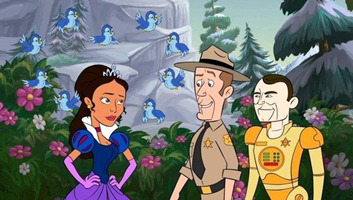
In the Looney Tunes style, developed by Tex Avery was designed to diverge from Disney-esque sentimentality and make cartoons that appealed equally to adults and children. A common quote associated with Avery's style “in cartoon you can do anything” (Adamson, 1975)
It is interesting to note that in both this and the Claymation style, Jo is seen to be portrayed as a princess. One with a similar aesthetic to Snow White with just a slight colour palette shift. There’s even the singing birds to reinforce the point further.
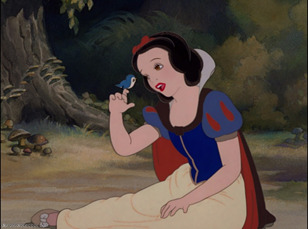
Fig. 3. Snow White with a blue bird (Frost, 2012)
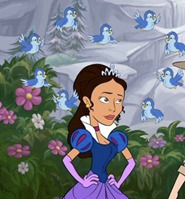
Fig.4. Jo Enters and “Jo White” (Joe, 2011)

Fig. 5. Snow White being playfully dragged by her bird companions (Rhiannon, 2018)
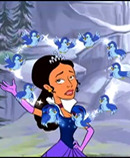
Fig.6. Jo explaining how she became “Jo White” (McCreary, 2011)
Snow White was the first Disney princess. She’s only 14 so she comes across as vulnerable and perfect. Pure in a very pretty way. She’s overall innocent. Her colour palette only supports this. Based on information of colour theory (Rikard 2015) I can say that using bright red on the lips, head bad and inside cloak gives a sense of passion and joy to the character. The yellow of her dress can be associated with freshness and, again, joy. The freshness in particular applies because Snow White is very young and she was the first Disney character of her type so was like a breath of fresh air in the animation scene. Even using White in her name signifies purity and delicacy. Two things Snow White definitely represents.
When we compare Jo to this we can see that the colours work in a different way. Here the dark blue is important to Jo’s character as it represents Jo’s extensive knowledge of weapons and is quite the powerhouse. She’s quite serious, favouring practicality over passion and the use of dark blue is a tribute to that.
Using gloves alone is an interesting design choice. In this particular instance it could be said that they represent Jo’s“camouflaged desire and emphasise her subconscious attempt to distance herself from others, hiding their true character (dbmoviesblog, 2016.) Jo does tend to be distant. This was the shows Christmas special and it was seen that Jo was planning to spend the holidays working, avoiding her friends. It also relates to her secret ambition to be a dancer. Using Light purple as the colour for the gloves makes the use of them even more interesting as light purple often evokes nostalgic feelings which would play into Jo’s memory of her home life and giving up on dreams.
To conclude. It is clear that Jo is a strong female character. She’s independent and can hold her own but based on how she is represented in animation, we can also say that she contradicts this slightly. Being represented as a trope that is supposed to be the pillar of vulnerability and femininity and being comparable to the dainty Snow White certainly gets is the way of that image that Jo portrays. It shows that she does go against it and that the strong woman character is just on the exterior and that at her core, Jo is quite feminine and girly.
Bibliography
Acuna, Kristen and Oswald, Angelica, Here’s The Cast Of Disney’s Live-Action Mulan And Who They’re Playing, blog, insider, 2019
https://www.insider.com/mulan-live-action-cast-vs-animated-2018-4
Date accessed: Monday 4th November 2019
Adamson, Joe,Tex Avery: King Of Cartoons, New York: Da Capo Press, 1975
Dbmovieblog, Gloves In Films: Hiding True Character and Desires, Wordpress, 2016
https://www.google.co.uk/amp/s/dbmoviesblog.wordpress.com/2017/04/17/gloves-in-films-hiding-true-character-desires/amp/
Date accessed: Monday 4th November 2019
Frost, John, Snow White To Celebrate 75th Anniversary With Special Screening NYC, blog, The Disney Blog, 2012
https://thedisneyblog.com/2012/09/17/snow-white-to-celebrate-75th-anniversary-with-special-screening-in-nyc/
Date accessed: Monday 4th November 2019
Joe, EUREKA 4.21: Do You See What I See, blog, Wordpress, 2011
https://www.google.co.uk/amp/s/joediliberto.wordpress.com/2011/12/07/eureka-4-21-do-you-see-what-i-see/amp/
Date accessed: Monday 4th November 2019
McCreary, Bear, Eureka Do You See What I See, blog, Bear McCreary Composer for film, television and games official site, 2011
http://www.bearmccreary.com/#blog/blog/eureka/eureka-do-you-see-what-i-see/
Date accessed: Monday 4th November 2019
Rikard, The Psychology Of Colour: A Designer’s Guide to Colour Association Meaning, blog, 2015
https://zevendesign.com/color-association/
Date accessed: Monday 4th November 2019
Rhiannon, Alexis, Freeform’s Snow White And The Seven Dwarfs’ Marathon Will Celebrate The Anniversary Of The Ground Breaking Disney Classic, blog, Bustle, 2018
https://www.bustle.com/p/freeforms-snow-white-the-seven-dwarfs-marathon-will-celebrate-the-anniversary-of-the-ground-breaking-disney-classic-8072880
Date accessed: Monday 4th November 2019
Vogler,Christopher, The Writers Journey Mythic Structure For Writers Third Addition, San Francisco, Micheal Weise Production, 2007
0 notes
Text
Character Research Project, Independent Study: Second Draft
To what extent can Jo Lupo be described as a strong female character and how does her animated alter-ego contradict this?
Imagine a town in the Pacific Northwest of America (Oregon,) that’s full of the world's geniuses. Life there shifts from incredible innovation to total chaos. This is A Town Called Eureka. The TV show where my character that I am going to be talking about comes from.
Thank
Jo, played by Erica Cerra, is my favorite character from the series but that’s not why I chose to analyse her. She’s interesting. In terms of characterization and development she goes on a journey. We get to see her grow and become vulnerable in a very mature way.
I’m this essay I’m going to be discussing the factors that make Jo a strong female character but I’m also going to analyse the internal battle that she has with herself and how the animated alter-ego could possibly be a representation of a repressed desire.
Jo Lupo. She starts off as a guarded individual our introduction to her is a closed off deputy who can disassemble and reassemble it in a matter of seconds.
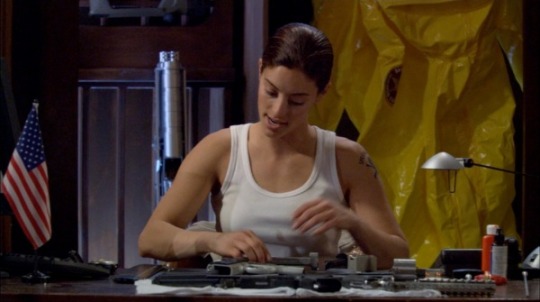
Throughout the series we learn that Jo is very much an ally archetype character(Vogler 2007.) She sticks by and acts as a support for our hero Jack Carter. Emotionally and physically. Mostly physically.
She always has a weapon with her, and goes armed even in situations where weaponry is unnecessary.Jo has a love of weapons, with a varied and powerful collection stored in the station, including several handguns, shotguns, sniper rifles, and assault rifles. She is also unusually strong for her size as she can manhandle Jack Carter with ease. The residents of the town and their odd experiments try her patience, but those few moments where she gets to shoot something are the moments that Jo enjoys and looks forward to the most.The residents themselves know and trust Jo, She’s very dependable and gets the job done.
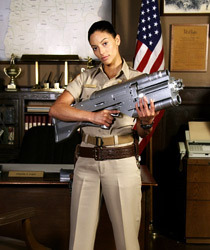
(Craddock, 2007)
Jo is also extremely independent to a fault. All of these factors make up the classic trope of a strong female character. We can see this more clearly by comparing Jo to Mulan (Disney’s Mulan 1998)

(Acuna and Oswald, 2019)
Mulan is stubborn, determined and as she shows when she climbs the pole, surprisingly strong. It isn’t just strength that determines a strong female character or any strong character. They need to be strong of the mind-able to face adversity head on and move on from it, they need to be stubborn/independent to a fault because that’s how they grow and change.
In the episode Noche de Suenos Jo reveals to Carter that she wanted to be a dancer as a young girl. In the same episode it is also revealed that she grew up without a mother but was old enough to remember the costumes her mother would make for her for various roles in school plays. Without her mother Jo grew up with three older brothers and a father. This led jo to believe that she had to “learn to survive” and so she gave up on her ambition to be a dancer.
This portrays a softer side to Jo’s character. A vulnerable side even. In the shows last season it’s also revealed that Jo is a big fan of weddings to the point where she likes to plan them and takes over planning Grace and Henry’s whilst going completely over the top with the preparations.
It’s this softer side to Jo that was the inspiration for how her animated alter ego was made to look.
in the episode “Do You See What I See?” a mysterious kaleidoscopic wave of colour washes over the town, transforming the characters into animated versions of themselves.This was caused by a Super Photon Generator And a holographic popup book crossing signals. The episode was animated by Curious Pictures and featured a style inspired by looney toons, claymation and anime. During this time the characters do not seem to be fundamentally changed but they often reflect the philosophy of the style that there animated in at the time.
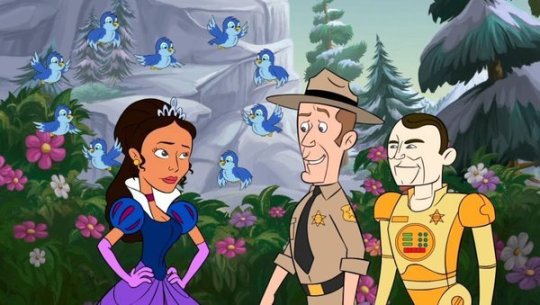
In the Looney Toons style, developed by Tex Avery was designed to diverge from Disney-esque sentimentality and make cartoons that appealed equally to adults and children. A common quote associated with Avery's style “in cartoon you can do anything” (Adamson, 1975)
It is interesting to note that in both this and the claymation style, Jo is seen to be portrayed as a princess. One with a similar aesthetic to Snow White with just a slight colour palette shift. There’s even the singing birds to hammer the point in further.
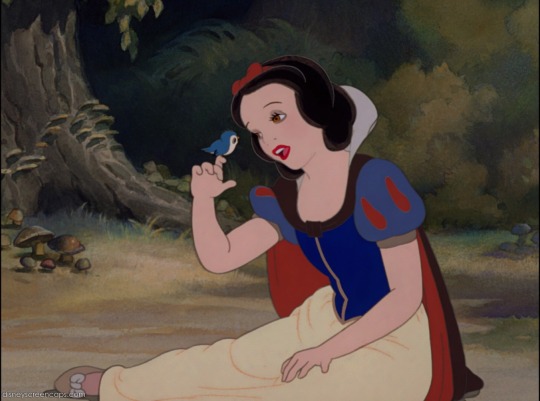
(Frost, 2012)

(Joe, 2011)
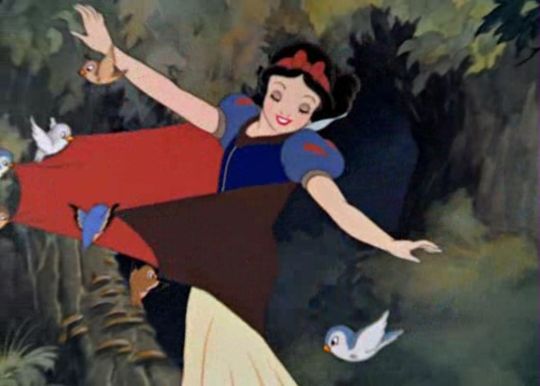
(Rhiannon, 2018)
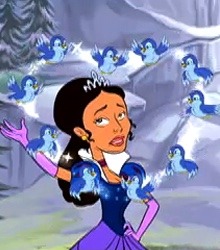
(McCreary, 2011)
Snow White was the first Disney princess. She’s only 14 so she comes across as vulnerable and perfect. Pure in a very pretty way. She’s overall innocent. Her colour palette only supports this. Based on information of colour theory (Rikard 2015) I can say that using bright read on the lips, head bad and inside cloak gives a sense of passion and joy to the character. The yellow of her dress can be associated with freshness and, again, joy. The freshness in particular applies because Snow White is very young and she was the first Disney character of her type so was like a breath of fresh air in the animation scene. Even using White in her name signifies purity and delicacy. Two things Snow White definitely represents.
When we compare Jo to this we can see that the colours work in a different way. Here the dark blue is important to Jo’s character as it represents knowledge, power, integrity and seriousness.
Jo has extensive knowledge of weapons and is quite the powerhouse. She’s quite serious, favouring practicality over passion and the use of dark blue is a tribute to that.
Using gloves alone is an interesting design choice. In this particular instance they represent Jo’s“camouflaged desire and emphasise her subconscious attempt to distance herself from
others, hiding their true character (dbmoviesblog, 2016.) Jo does tend to be distant. This was the shows Christmas special and it was seen that Jo was planning to spend the holidays working, avoiding her friends. It also relates to her ambition to be a dancer and how she keeps that desire under wraps and only ever told Carter. Using Light purple as the colour for the gloves makes the use of them even more interesting as light purple often evokes nostalgic feelings which would play into Jo’s memory of her home life and giving up on dreams.
To conclude. It is clear that Jo is a strong female character. She’s independent and can hold her own but based on how she is represented in animation, we can also say that she contradicts this slightly. Being represented as a trope that is supposed to be the pillar of vulnerability and femininity and being comparable to the dainty Snow White certainly gets is the way of that image that Jo portrays. It shows that she does go against it and that the strong woman character is just on the exterior and that at her core, Jo is quite feminine and girly. But don’t let her hear you say that.
Bibliography
Acuna, Kristen and Oswald, Angelica, Here’s The Cast Of Disney’s Live-Action Mulan And Who They’re Playing, blog, insider, 2019
https://www.insider.com/mulan-live-action-cast-vs-animated-2018-4
Adamson, Joe,Tex Avery: King Of Cartoons, New York: Da Capo Press, 1975
Craddock, Linda, Interview For Sci-Fi World, Transcript, Sci-Fi World. Net, 2007
http://www.thescifiworld.net/interviews/erica_cerra_01.htm
Dbmovieblog, Gloves In Films: Hiding True Character and Desires, Wordpress, 2016
https://www.google.co.uk/amp/s/dbmoviesblog.wordpress.com/2017/04/17/gloves-in-films-hiding-true-character-desires/amp/
Frost, John, Snow White To Celebrate 75th Anniversary With Special Screening NYC, blog, The Disney Blog, 2012
https://thedisneyblog.com/2012/09/17/snow-white-to-celebrate-75th-anniversary-with-special-screening-in-nyc/
Joe, EUREKA 4.21: Do You See What I See, blog, Wordpress, 2011
https://www.google.co.uk/amp/s/joediliberto.wordpress.com/2011/12/07/eureka-4-21-do-you-see-what-i-see/amp/
McCreary, Bear, Eureka Do You See What I See, blog, Bear McCreary Composer for film, television and games official site, 2011
http://www.bearmccreary.com/#blog/blog/eureka/eureka-do-you-see-what-i-see/
Rikard, The Psychology Of Colour: A Designer’s Guide to Colour Association Meaning, blog, 2015
https://zevendesign.com/color-association/
Rhiannon, Alexis, Freeform’s Snow White And The Seven Dwarfs’ Marathon Will Celebrate The Anniversary Of The Ground Breaking Disney Classic, blog, Bustle, 2018
https://www.bustle.com/p/freeforms-snow-white-the-seven-dwarfs-marathon-will-celebrate-the-anniversary-of-the-ground-breaking-disney-classic-8072880
Vogler,Christopher, The Writers Journey Mythic Structure For Writers Third Addition, San Francisco, Micheal Weise Production, 2007
0 notes